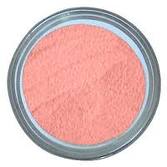What is copper powder?
Characteristics: Distinctive reddish color; ductile; excellent conductor of electricity. Complexing agent, coordination numbers 2 and 4. Dissolves readily in nitric and hot concentrated H2SO4, in HCl and dilute H2SO4 slowly but only when exposed to the atmosphere. More resistant to atmospheric corrosion than iron, forming a green layer of hydrated basic carbonate. Readily attacked by alkalies. A necessary trace element in human diet; a factor in plant metabolism. Essentially nontoxic in elemental form. Powder is combustible.
 Derivation: With sulfide ores the steps may be Derivation: With sulfide ores the steps may be
(1) concentration (of low grade ores) by flotation and leaching
(2) roasting
(3) formation of copper “matte” (40-50% Cu)
(4) reduction of matte to “blister” copper (96-98%)
(5) electrolytic refining to 99.9+% copper
Hazard: Toxic and flammable in finely divided form.
Tolerance (fume) 0.2 mg/m3; (dusts and mists) 1 mg/m3.
Using Copper Powders
Copper and copper alloy powders have been used in industrial applications for many years. Probably the best known is the self-lubricating bearing which was the first major application and still accounts for about 70% of the granular copper powder used. This application takes advantage of the ability to produce a component with controlled interconnected and surface-connected porosity. The production of metallic filters also takes advantage of this ability.
Pure copper powder is used in the electrical and the electronics industries because of its excellent electrical and thermal conductivities. Alloyed with tin, zinc, nickel and other elements, copper in powder form is used in structural parts and friction materials. Brasses, bronzes and other copper alloys produced by powder metallurgy methods have the physical and mechanical properties of their cast or wrought counterparts. Copper is used also as an alloying element in iron powder components to enhance the mechanical properties and control dimensional changes during sintering, the addition being made either by mixing or by infiltration.
In addition to the above applications of granular copper powder, a large quantity of copper and copper alloy powder is used in flake form, i.e., as a powder whose thickness is small in relation to its other dimensions. Such powders are used, for example, in antifouling paints, decorative and protective coatings and printing inks.
Copper and copper alloy powders are also used in such nonstructural applications as brazing, cold soldering, and mechanical plating, as well as for medals and medallions, metal-plastic decorative products and a variety of chemical and medical purposes.
Chemical Composition
Cu(≮,%) |
99.7 |
Impurities Analysis(≯,%) |
Fe |
0.02 |
Pb |
0.005 |
As |
0.005 |
Sb |
0.01 |
O |
0.20 |
SO4=(≯,%) |
0.004 |
Cl—(≯,%) |
0.004 |
H2O(≯,%) |
0.05 |
Calcined residue after nitric acid treatment(≯,%) |
0.05 |
Total Amount of Impurities |
0.3 |
Physical Properties
Designation of Product |
Particle Size |
Bulk Density
(g/cm3) |
Particle Distribution |
% |
FTD1 |
—200 Mesh |
≥90 |
1.5~2.3 |
In which—300 Mesh |
≥60 |
FTD2 |
—300 Mesh |
≥95 |
1.2~1.7 |
FTD3 |
—200 Mesh |
≥95 |
1.5~1.9 |
FTD4 |
—80~200 Mesh |
70~80 |
1.8~2.5 |
If you have any interest in copper powder, please feel free to contact us by email: sales@chinatungsten.com or by telephone:+86 592 5129696.
More info>>
1.Tungsten Powder
2.Catalog of Tungsten Powder
3.Molybdenum Powder |







